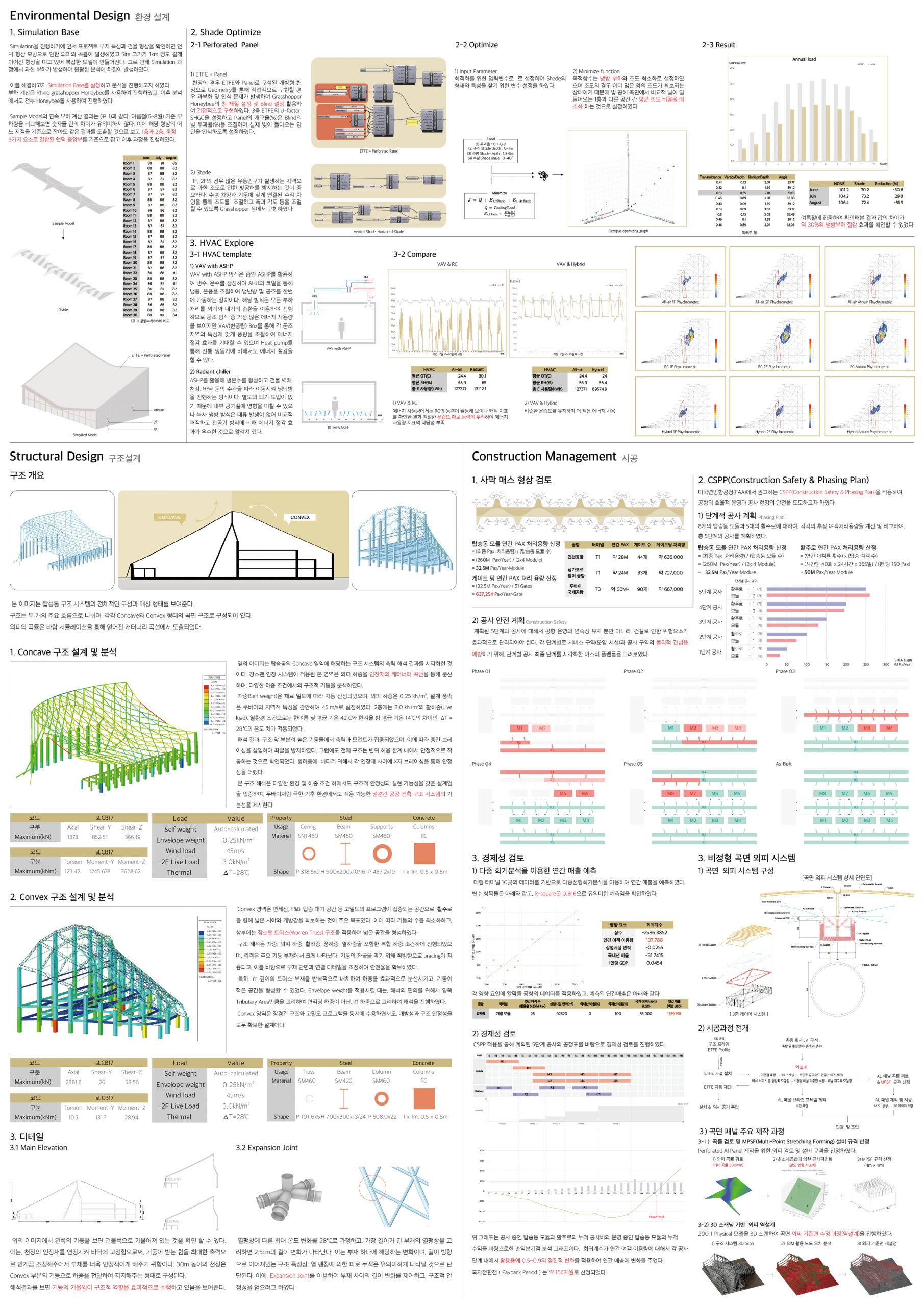카다이프 (서원주, 박종후, 박중혁) _ Dubai Al Maktoum Airport Design Modification : 알막툼 공항의 상징적 재구성에 대한 공학적 제안
알막툼 국제공항은 아랍에미리트 두바이에 위치한 국제공항으로, 두바이 도심에서 남서쪽으로 약 37km 떨어진 자리에 위치한다. 현재는 중동 지역의 대표적인 허브 공항인 두바이 국제공항의 보조 공항 역할을 하고 있지만, 두바이 국제공항의 두 배에 달하는 여객을 처리하는 거대한 신공항으로 탈바꿈하기 위해 활주로 동쪽 방향으로 확장 공사가 진행 중이다. 기존에는 주로 화물 노선을 중심으로 운영되었으나, 향후에는 여객 중심의 대형 허브 공항으로서의 기능을 수행할 계획이다.
이번 졸업 전시에서는 ‘알막툼 국제공항 재설계’를 주제로 삼아 프로젝트를 진행하였다. 공항은 한 국가를 방문할 때 가장 먼저 마주하게 되는 공간이며, 그중에서도 탑승동은 여행자의 첫인상을 결정짓는 중요한 건축물이다. 단순한 기능적 공간 이상의 의미를 지니는 공항 탑승동을, 그 나라의 정체성을 담아낸 건축물로 설계한다면 방문자들에게 더욱 강렬하고 인상적인 경험을 제공할 수 있을 것이다.
이에 우리는 '두바이'라는 도시의 상징성과 자연적 풍경에서 영감을 얻어 설계 방향을 잡았다. 두바이라고 하면 자연스럽게 떠오르는 이미지 중 하나는 드넓게 펼쳐진 사막과 그 속의 유려한 언덕들이다. 끊임없이 변화하는 모래 언덕의 곡선과 부드러운 실루엣은 두바이 특유의 자연미를 대표한다. 따라서 우리는 이러한 사막 언덕의 형상을 탑승동의 주요 디자인 모티프로 삼아 설계를 진행하였다.
또한, 두바이는 극단적인 기후 조건으로도 유명하다. 여름철에는 섭씨 50도에 가까운 고온이 지속되고, 사막 특유의 거친 모래 바람과 건조한 환경도 큰 도전 요소가 된다. 그러나 동시에 두바이는 풍부한 석유 자원을 바탕으로 한 경제력과 최첨단 기술력으로 세계적인 고층 건물과 혁신적인 구조물을 지속적으로 탄생시키는 도시이기도 하다. 이러한 지역적 특성과 기술적 역량을 설계에 반영하여, 사막 환경 속에서도 견고하고 쾌적한 공간을 구현할 수 있는 구조와 재료를 적극적으로 고려하였다.
우리 팀의 설계안은 사막 언덕의 자연스러운 곡선미를 건축적 형태로 해석하여 공항 탑승동의 외피에 적용하였다. 유려한 외관과 함께 내부 공간은 자연광을 적절히 활용할 수 있도록 구성하였고, 동시에 외부의 열과 모래로부터 내부를 보호하는 고성능 외피 시스템을 계획하였다. 구조적으로는 장스팬 구조를 도입하여 넓고 개방적인 내부 공간을 확보하고, 방문객들이 보다 편안하고 흥미로운 공간 경험을 누릴 수 있도록 하였다.
이번 프로젝트를 통해 우리는 기능성과 심미성, 그리고 지역적 특성을 조화롭게 담아내는 공항 탑승동 설계의 가능성을 모색해보았다. 단순히 교통의 허브가 아닌, 도시와 국가의 이미지를 세계에 전달하는 상징적 공간으로서의 공항 건축이 지닌 가치와 역할에 대해 집중하였다.
Al Maktoum International Airport is located in Dubai, United Arab Emirates, approximately 37 kilometers southwest of downtown Dubai.
While it currently serves as a supplementary airport to Dubai International Airport — the primary hub of the Middle East — expansion work is underway to transform it into a massive new airport capable of handling twice the passenger traffic of its predecessor. Originally operated primarily for cargo routes, it is now being developed to function as a major passenger-focused hub airport.
For our graduation exhibition, we chose the theme of "Redesigning Al Maktoum International Airport" as the foundation of our project.
An airport is the very first space one encounters when visiting a country, and among its components, the concourse plays a critical role in forming first impressions. If this functional space is reimagined as an architectural embodiment of the nation's identity, it can offer visitors a much stronger and more memorable experience.
We therefore drew inspiration from the symbolic imagery and natural landscape of Dubai.
One of the most iconic images associated with the city is its vast desert and the graceful sand dunes it contains. The ever-shifting curves and smooth silhouettes of these dunes are a striking representation of Dubai’s natural beauty.
Accordingly, we adopted the form of sand dunes as the primary design motif for the concourse structure.
Dubai is also known for its extreme climate conditions, with summer temperatures nearing 50°C, frequent sandstorms, and an arid atmosphere.
Yet at the same time, the city is renowned for its economic power backed by oil wealth and advanced technological infrastructure, which have enabled the creation of world-class skyscrapers and pioneering structures.
Our design incorporates these regional and technological characteristics by selecting materials and structural systems that ensure both durability and comfort within the desert environment.
Our team’s proposal interprets the natural curves of desert dunes into an architectural form applied to the outer shell of the airport concourse.
While expressing a fluid and elegant exterior, we also designed the interior to maximize the use of natural light, and applied a high-performance facade system to protect the interior from external heat and sand.
Structurally, we implemented a long-span system to create a spacious, open interior, allowing visitors to enjoy a more comfortable and engaging spatial experience.
Through this project, we sought to explore the potential of concourse design that harmoniously integrates functionality, aesthetics, and regional context.
We focused on the value and role of airport architecture not merely as a transportation hub, but as a symbolic space that communicates the image of a city and a nation to the world.

